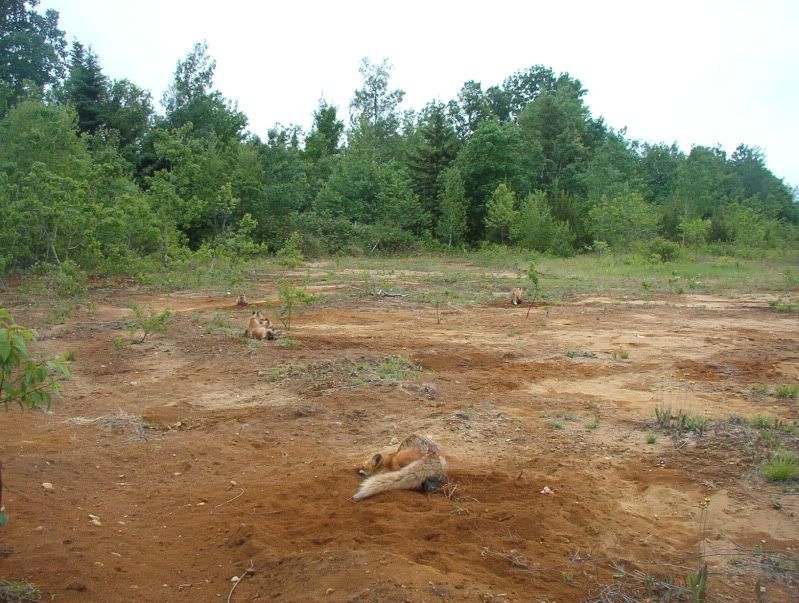|
|
Post by jsevering on Mar 27, 2012 8:06:26 GMT -6
think social structures are different... different areas... my idea of a transient and could be all wet is the mature pup roughly a year old or so, not sexually matured... think like 1080 related food base has a lot to do with it in overlapping territories also... type of food base in winter also...
to me transient and dispersal is something different... think transients are capable of staying within certain territories as part of that social structure, possibly looking to fill a void within one of the family groups... think at least in part true dispersal is a function of the social structure's need...
............................................................................................................
during this study, not one confirmed deer/fawn kill by any of the collared coyotes
.............................................................................................................
here again and maybe kinda related some, in my mind... deer are pretty much targeted during winter and the social structure may be a hair different who knows.. fawns are an excellent source of food for whelping the pups also here until other things kick in...
i imagine you must have a decent more reliable prey base, rodent wise which could effect things some?... jim
|
|
|
|
Post by trappnman on Mar 27, 2012 10:17:04 GMT -6
here is a good one concerning dispersal www.aphis.usda.gov/wildlife_damage/nwrc/publications/96pubs/96-34.pdfThe tables are real confusing, but the spatial territories and overlap charts are good- Its summed up nicely in the Discussion, and this stands out- Coyotes that dispersed were low-ranking individuals
that were subordinate to other animals in the
dominance hierarchy, spent little time with other
pack members, had little access to carcasses and
were less skilled at hunting small mammals during
the year when pack size was greatest. We emphasize,
however, that we never observed dominant
coyotes chasing a pack member and forcing the
subordinate coyote to disperse. Instead, we believe
that the culmination of different social and nutritional
pressures reaches a certain level, and the
individual voluntarily leaves the territory to seek
resources (food and/or breeding opportunities)
elsewhere.here's one in Idaho, showing distances traveled among other things in 24 hr periods. as 1080 says- little different than our coyotes here www.vetmed.wsu.edu/org_nws/NWSci%20journal%20articles/1982%20files/Issue%203/v56%20p199%20Woodruff%20and%20Keller.PDFthis is interesting- Analysis of capture points revealed that no coyote was captured in a heavily used or preferred area of the home range. This observation is similar to that documented by Hibler and Knowlton (1974) and Rucker (1975). A combination of familiarity
with the heavily used parts of the home range and increased awareness of scent stations outside these areas may contribute to a higher trapability of animals in fringe areas................ Capture points were analyzed with respect to their location in the home range. The modified minimum area method was used to estimate home range boundaries during the
analysis. In 50 percent of the cases, the capture point was either outside or on the border of the home range. In the remaining cases the capture point was not more than 0.5 km inside the border.and- If the Minnesota figures are adjusted accordingly, coyote home ranges in Idaho averaged 2.5 to 3.5 rimes larger. Estimates obtained in our study substantiate those of Rucker (1975) and Edwards ( 1975 ) to earlier telemetry studies on the INEL
Site. It appears that the size of the area used by a coyote may be a function of population density, food base, differences in habitat, pressure by man or a combination of these factors.Male coyote 24 dispersed about l3 km off the Site and
established a home range adjacent to cultivated land. The home range of this animal was estimated as approximately 10 and 20 percent of the home range sizes for the adult male (38) and juvenile female (26), respectively (Table 1). A variety of factors
may have contributed to this low estimate. the non arable habitat that coyote 24 utilized was surrounded by farmland and only encompassed an area of 15km squared since a kilometer is .6 of a mile, 15 km would be about 9 miles- so even with this "smaller" territory 9 miles squared is a range of 80 or so miles....... if i'm doing the math right quite different indeed! |
|
|
|
Post by Zagman on Mar 27, 2012 12:29:16 GMT -6
Steve......(Gappa)
With such a preponderance of doubles on the spot, do you feel a third and fourth trap at these locations would yield trips and quads, or even more?
Small territory............fall family group trapping.....high percentage of doubles.......24 hour check...........on "the spot"
Seems like it is screaming for more traps, no?
MZ
|
|
|
|
Post by Stef on Mar 27, 2012 12:53:30 GMT -6
6 traps there, 3 per rows all close together. End up with 5 in 4 traps. Think I just need 4 next time    I know i know... they aren't yotes   |
|
|
|
Post by trappnman on Mar 27, 2012 14:04:52 GMT -6
without a doubt, without a doubt-
I was setting 2 traps as a constant- a control if you will
I'll be gangsetting some locations if the sign warrents with 4-6 traps.
I know I lost coyotes by setting only 2 but in doing so, but I gained knowledge- and formost, that if "there" I didn't need to stay weeks. I honestly think I'll have sevreal triples this year and I'd really like a quad.
and always keep in mind, I'm just a pilgrim at this- 2 years under my belt of run and gun- as 1080 points out I think I know more than I do.....
but I know more now than I did 3 years ago- and will know more the next and next the next.
|
|
|
|
Post by trappnman on Mar 27, 2012 14:05:38 GMT -6
now thats exactly what I'm talking about stef!
what lures did you use..........
|
|
|
|
Post by Stef on Mar 27, 2012 14:25:02 GMT -6
I don't remember exactly but what I can remember is:
All dirt hole sets
All of them had my Champion bait.
Some with urine in the holes or backing (no mist) with bait.
And 1 set had bait + Cachottier for sure (female caught on that one) and a hole had some Indispensable + Champion bait.
Think that was what I used.
I don't think I'll be able to repeat a catch like I did but it was fun for sure...LoL
|
|
|
|
Post by trappnman on Mar 27, 2012 17:54:31 GMT -6
We took the last thread as far as it would go, so lets start anew.....
|
|
|
|
Post by jsevering on Mar 29, 2012 19:43:59 GMT -6
so we have three distinct location types-
#1- stall out areas
#2- home ranges before dispersal
#3- sporadic traveling locations
and their importance to me, is also listed in same order as 1, 2 ,3
so the goal is to eliminate all the #3, and concentrate on #1s, with of course reliance on #2 locations as well.
.............................................................................................................
still would of liked if someone would of cleared up social structure a hair, being a layman, dumb ass average normal type trapper, i have a hard time with it ... seems whats being described is somewhat dependent on it....
be nice to have a general description of the type betas, transients, associates, displaced alpha's and dispersal types in general, where they get clumped into imagine at the given point in time between 3 and 30 it will defiantly come into play... in regards to the areas of what you are searching for would come into play, in part
could kinda see where the need to defend 3 would be greater than the need to defend 30 think the difference in other prey abundance types may play a part some also... (realize we were talking two-three weeks run and gun for the most part... fall family groups)
but the difference between three and thirty is quite a lot... and the social structures implied between three and thirty is.. is capable of being a pretty big variant number wise... especially how the overall stall out is being described or implied through out the thread...
so i guess what im getting at is, all things being equal, and the probable possible capable social structures between three and thirty is gonna be a hair different...... how do you know or determine if that's the actual thirty zone if there isnt really thirty... say all piles on any given average farm is three and the prey base is only fair to. middling ..
is there something that helps you key in on the actual possible existing social structures present, say if most everything is equal... jim
|
|
|
|
Post by trappnman on Mar 30, 2012 6:59:17 GMT -6
a couple of the links, went into depth on that subject. Quite in depth in some of them. Not sure what you are looking for?
In my opinion the point isn't really 3 or thirty- its the reaction of animals based on abundant carrion vs not so much, and how (the Idaho study showed this nicely) number and ratio of animals changed within a pack, and how packs interacted with an abundance of easy (dead) food vs having to hunt for that food (small mammals,etc). Social structure (behaviors) in other words.
|
|